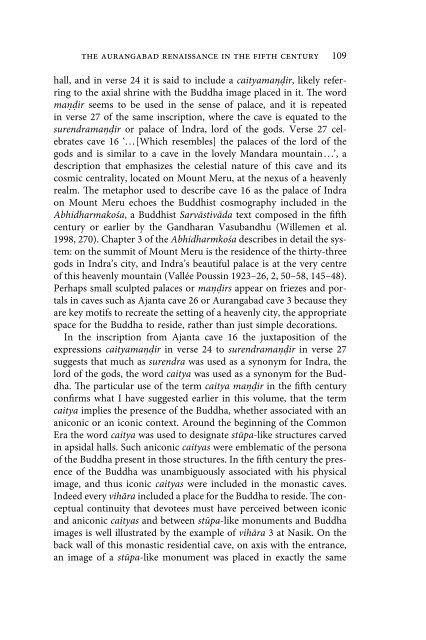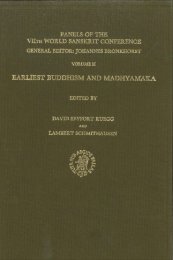- Page 2 and 3:
The Buddhist Caves at Aurangabad: T
- Page 4 and 5:
The Buddhist Caves at Aurangabad: T
- Page 6:
Ai miei genitori Ludovico e Maria R
- Page 9 and 10:
viii contents 2.10 The Aurangabad C
- Page 12 and 13:
LIST OF ILLUSTRATIONS Figure 1. Map
- Page 14 and 15:
list of illustrations xiii Figure 5
- Page 16 and 17:
list of illustrations xv Figure 94.
- Page 18 and 19:
list of illustrations xvii Figure 1
- Page 20 and 21:
ACKNOWLEDGMENTS This project is the
- Page 22:
acknowledgments xxi scholar and gen
- Page 25 and 26:
2 introduction at its core (cave 4)
- Page 27 and 28:
4 introduction problems. Most relev
- Page 29 and 30:
6 introduction involvement of ordin
- Page 31 and 32:
8 chapter one the same slope and fa
- Page 33 and 34:
10 chapter one (fig. 12). Female fi
- Page 35 and 36:
12 chapter one a princely bodhisatt
- Page 37 and 38:
14 chapter one towards the halo rad
- Page 39 and 40:
16 chapter one wall to the left of
- Page 41 and 42:
18 chapter one crown bears the effi
- Page 43 and 44:
20 chapter one On the other side of
- Page 45 and 46:
22 chapter one may be that such ima
- Page 47 and 48:
24 chapter one the access to the sh
- Page 49 and 50:
26 chapter two all the kings used d
- Page 51 and 52:
28 chapter two Aurangabad 4 has sto
- Page 53 and 54:
30 chapter two functioned together,
- Page 55 and 56:
32 chapter two for each site and th
- Page 57 and 58:
34 chapter two Larger sites blossom
- Page 59 and 60:
36 chapter two 2.5 Archaism Archais
- Page 61 and 62:
38 chapter two to the south and con
- Page 63 and 64:
40 chapter two previously, we are f
- Page 65 and 66:
42 chapter two The Kriyāsaṃ grah
- Page 67 and 68:
44 chapter two Schopen has suggeste
- Page 69 and 70:
46 chapter two caves of the western
- Page 71 and 72:
48 chapter two did not yield any ar
- Page 73 and 74:
50 chapter two the community to ack
- Page 75 and 76:
52 chapter two 2.9 The Vihāra at A
- Page 77 and 78:
54 chapter two Often the word ‘as
- Page 79 and 80:
56 chapter two monasteries of the K
- Page 81 and 82: 58 chapter two river and its tribut
- Page 83 and 84: 60 chapter two emphasis that Buddhi
- Page 85 and 86: 62 chapter two the caves preserve e
- Page 87 and 88: 64 chapter two cotton and other tex
- Page 89 and 90: 66 chapter two architecture emerged
- Page 91 and 92: 68 chapter two indisputable similar
- Page 93 and 94: 70 chapter two show up in Gandhara
- Page 95 and 96: 72 chapter three The first question
- Page 97 and 98: 74 chapter three drains into the In
- Page 99 and 100: 76 chapter three cross, the source
- Page 101 and 102: 78 chapter three they exploited the
- Page 103 and 104: 80 chapter three 3.2 International
- Page 105 and 106: 82 chapter three another well-known
- Page 107 and 108: 84 chapter three (Schlingloff 1974,
- Page 109 and 110: 86 chapter three This information g
- Page 111 and 112: 88 chapter three large quantities o
- Page 113 and 114: 90 chapter three While the sites of
- Page 115 and 116: 92 chapter three many skilled carve
- Page 117 and 118: 94 chapter three devotees were carv
- Page 119 and 120: 96 chapter three tionalized, the vo
- Page 121 and 122: 98 chapter three that in the first
- Page 123 and 124: 100 chapter three (fig. 37) and Aja
- Page 125 and 126: 102 chapter three of sacred sites h
- Page 127 and 128: 104 chapter three quadrangular mona
- Page 129 and 130: 106 chapter three 456 or 457 claims
- Page 131: 108 chapter three 3.7 The Buddha in
- Page 135 and 136: 112 chapter three what a gandhakut
- Page 137 and 138: 114 chapter three to the ones seen
- Page 139 and 140: 116 chapter three ārya-pudgala (ho
- Page 141 and 142: 118 chapter three at Aurangabad. Pe
- Page 143 and 144: 120 chapter three Perhaps the reins
- Page 145 and 146: 122 chapter three on the frieze (fi
- Page 148 and 149: CHAPTER FOUR BUDDHIST PRACTICE AT A
- Page 150 and 151: uddhist practice at aurangabad in t
- Page 152 and 153: uddhist practice at aurangabad in t
- Page 154 and 155: uddhist practice at aurangabad in t
- Page 156 and 157: uddhist practice at aurangabad in t
- Page 158 and 159: uddhist practice at aurangabad in t
- Page 160 and 161: uddhist practice at aurangabad in t
- Page 162 and 163: uddhist practice at aurangabad in t
- Page 164 and 165: uddhist practice at aurangabad in t
- Page 166 and 167: uddhist practice at aurangabad in t
- Page 168 and 169: uddhist practice at aurangabad in t
- Page 170 and 171: uddhist practice at aurangabad in t
- Page 172 and 173: uddhist practice at aurangabad in t
- Page 174 and 175: uddhist practice at aurangabad in t
- Page 176 and 177: uddhist practice at aurangabad in t
- Page 178 and 179: uddhist practice at aurangabad in t
- Page 180: uddhist practice at aurangabad in t
- Page 183 and 184:
160 chapter five the sacred area su
- Page 185 and 186:
162 chapter five of women desiring
- Page 187 and 188:
164 chapter five to the beginning o
- Page 189 and 190:
166 chapter five for goods moving t
- Page 191 and 192:
168 chapter five dhyānāsana; he w
- Page 193 and 194:
170 chapter five this sense the pre
- Page 195 and 196:
172 chapter five tradition of Nepal
- Page 197 and 198:
174 chapter five In summary, Vajrap
- Page 199 and 200:
176 chapter five (tārāvatī), ‘
- Page 201 and 202:
178 chapter five the beginning of t
- Page 203 and 204:
180 chapter five an āyudhapuruṣa
- Page 205 and 206:
182 chapter five female patronage.
- Page 207 and 208:
184 chapter five practice. Deities
- Page 209 and 210:
186 chapter five interior space, wi
- Page 211 and 212:
188 chapter five been recognized by
- Page 213 and 214:
190 chapter five with the function
- Page 215 and 216:
192 chapter five Avalokiteśvara. H
- Page 217 and 218:
194 chapter five For example, he re
- Page 219 and 220:
196 chapter five not a coincidence.
- Page 221 and 222:
198 chapter five Chinese pilgrim Fa
- Page 223 and 224:
200 chapter five devotees strived f
- Page 225 and 226:
202 chapter five well incorporate t
- Page 227 and 228:
204 chapter five that can be clearl
- Page 229 and 230:
206 chapter five unfinished, and th
- Page 231 and 232:
208 chapter five above indicate tha
- Page 233 and 234:
210 chapter five Mothers was part o
- Page 235 and 236:
212 chapter six rulers who controll
- Page 237 and 238:
214 chapter six who, based on a rea
- Page 239 and 240:
216 chapter six practices that, alt
- Page 241 and 242:
218 bibliography Boucher, D. “Gā
- Page 243 and 244:
220 bibliography Durt, H. ‘Daijo.
- Page 245 and 246:
222 bibliography Contacts in the In
- Page 247 and 248:
224 bibliography ——. Corpus Ins
- Page 249 and 250:
226 bibliography 2001. Vol. II, edi
- Page 251 and 252:
228 bibliography Verardi, G., and E
- Page 253 and 254:
230 index Divyāvadāna 43 n.22, 44
- Page 255 and 256:
232 index Skanda Purāṇa 144, 153
- Page 258:
ILLUSTRATION SECTION
- Page 261 and 262:
238 illustration section Figure 2.
- Page 263 and 264:
240 illustration section Figure 4.
- Page 265 and 266:
242 illustration section Figure 6.
- Page 267 and 268:
244 illustration section Figure 8.
- Page 269 and 270:
246 illustration section Figure 11.
- Page 271 and 272:
248 illustration section Figure 15.
- Page 273 and 274:
250 illustration section Figure 17.
- Page 275 and 276:
252 illustration section Figure 21.
- Page 277 and 278:
254 illustration section Figure 24.
- Page 279 and 280:
256 illustration section Figure 28.
- Page 281 and 282:
258 illustration section Figure 31.
- Page 283 and 284:
260 illustration section Figure 33.
- Page 285 and 286:
262 illustration section Figure 37.
- Page 287 and 288:
264 illustration section Figure 41.
- Page 289 and 290:
266 illustration section Figure 43.
- Page 291 and 292:
268 illustration section Figure 46.
- Page 293 and 294:
270 illustration section Figure 50.
- Page 295 and 296:
272 illustration section Figure 52.
- Page 297 and 298:
274 illustration section Figure 56.
- Page 299 and 300:
276 illustration section Figure 59.
- Page 301 and 302:
278 illustration section Figure 61.
- Page 303 and 304:
280 illustration section Figure 64.
- Page 305 and 306:
282 illustration section Figure 68.
- Page 307 and 308:
284 illustration section Figure 72.
- Page 309 and 310:
286 illustration section Figure 76.
- Page 311 and 312:
288 illustration section Figure 80.
- Page 313 and 314:
290 illustration section Figure 82.
- Page 315 and 316:
292 illustration section Figure 85.
- Page 317 and 318:
294 illustration section Figure 89.
- Page 319 and 320:
296 illustration section Figure 93.
- Page 321 and 322:
298 illustration section Figure 97.
- Page 323 and 324:
300 illustration section Figure 101
- Page 325 and 326:
302 illustration section Figure 105
- Page 327 and 328:
304 illustration section Figure 108
- Page 329 and 330:
306 illustration section Figure 111
- Page 331 and 332:
308 illustration section Figure 115
- Page 333 and 334:
310 illustration section Figure 119
- Page 335 and 336:
312 illustration section Figure 123
- Page 337 and 338:
314 illustration section Figure 126
- Page 339 and 340:
316 illustration section Figure 130
- Page 341 and 342:
318 illustration section Figure 133
- Page 343 and 344:
320 illustration section Figure 136
- Page 345 and 346:
322 illustration section Figure 140
- Page 347 and 348:
324 illustration section Figure 144
- Page 349 and 350:
326 illustration section Figure 148
- Page 351 and 352:
328 illustration section Figure 152
- Page 353 and 354:
330 illustration section Figure 156
- Page 355:
332 illustration section Figure 160





